Corporations Law Case Study Assignment: Restaurant Business
VerifiedAdded on 2023/04/03
|10
|2108
|271
Case Study
AI Summary
This case study assignment delves into Corporations Law, presenting a comprehensive analysis of a family-owned restaurant's transition from a sole proprietorship to a company structure. The first part addresses the steps involved in incorporating a business, comparing the advantages and disadvantages of operating as a company versus a sole trader, and advising the business owners on the implications of their decisions. The second part examines the legal position of a company, focusing on agency law and the authority of agents acting on behalf of the company, including the application of the rule in Royal British Bank v Turquand and its exceptions. The assignment provides a detailed application of legal principles to the facts of the case, offering recommendations and conclusions based on the analysis of relevant legislation and case law.
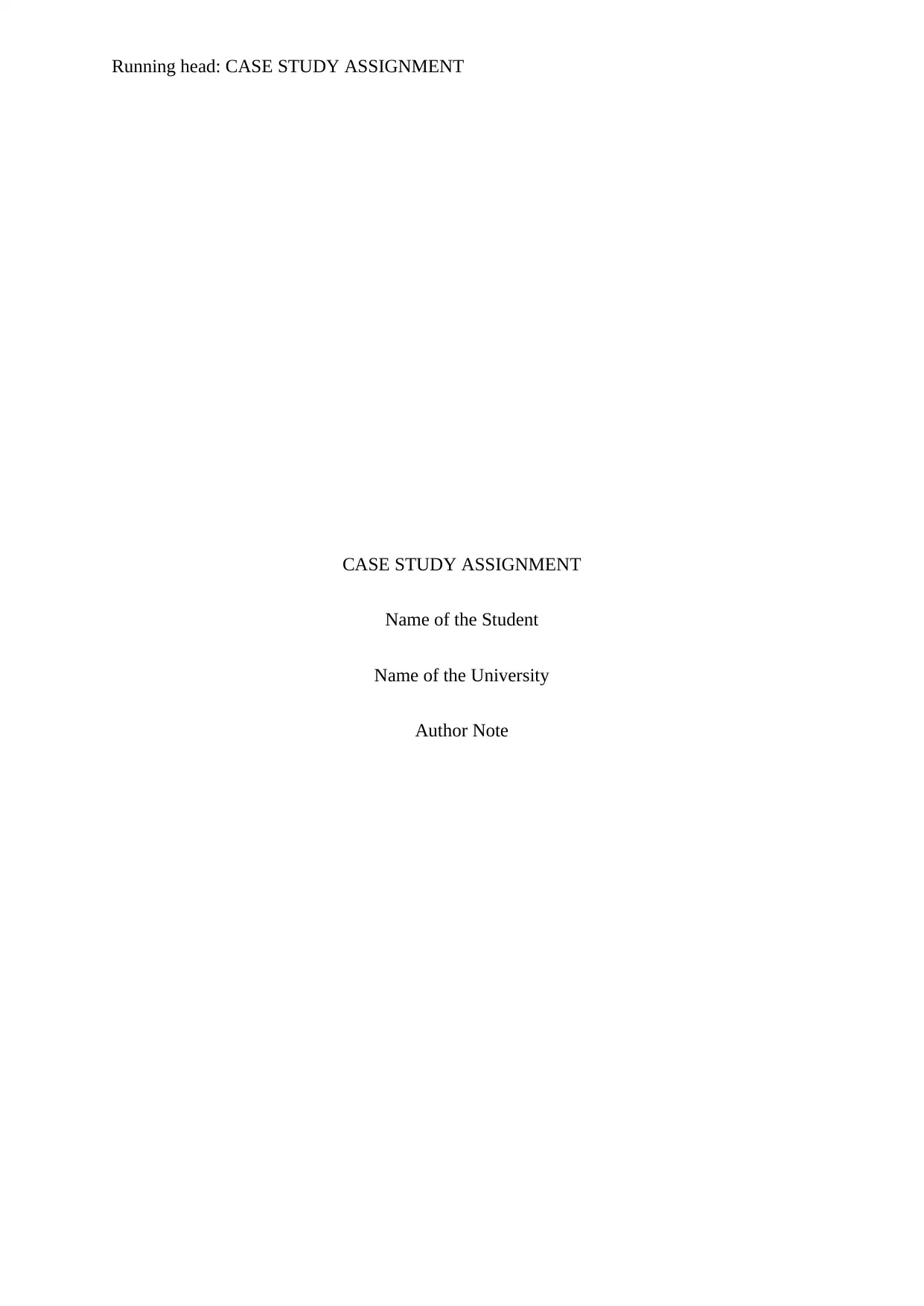
Running head: CASE STUDY ASSIGNMENT
CASE STUDY ASSIGNMENT
Name of the Student
Name of the University
Author Note
CASE STUDY ASSIGNMENT
Name of the Student
Name of the University
Author Note
Paraphrase This Document
Need a fresh take? Get an instant paraphrase of this document with our AI Paraphraser
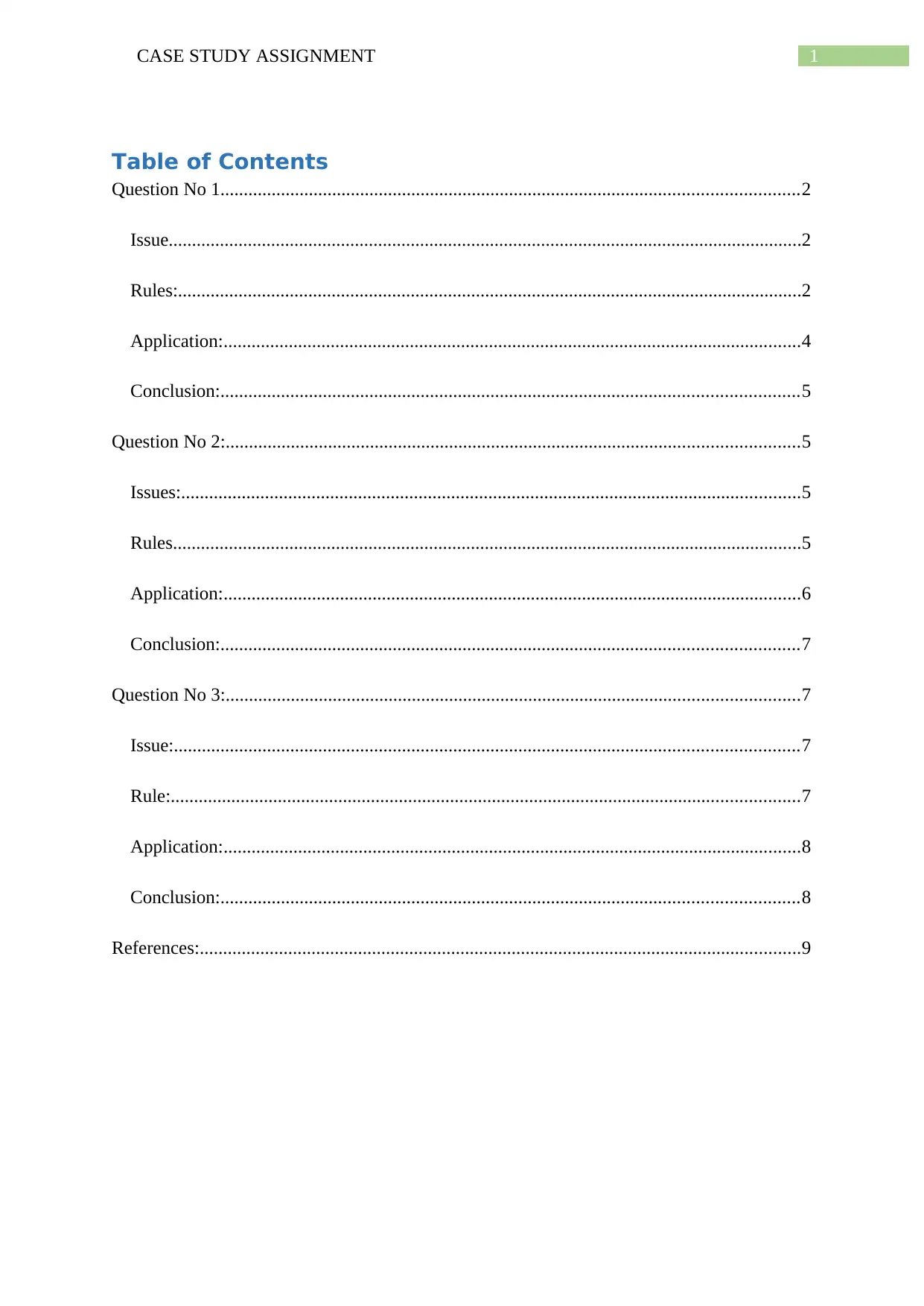
1CASE STUDY ASSIGNMENT
Table of Contents
Question No 1............................................................................................................................2
Issue........................................................................................................................................2
Rules:......................................................................................................................................2
Application:............................................................................................................................4
Conclusion:............................................................................................................................5
Question No 2:...........................................................................................................................5
Issues:.....................................................................................................................................5
Rules.......................................................................................................................................5
Application:............................................................................................................................6
Conclusion:............................................................................................................................7
Question No 3:...........................................................................................................................7
Issue:......................................................................................................................................7
Rule:.......................................................................................................................................7
Application:............................................................................................................................8
Conclusion:............................................................................................................................8
References:.................................................................................................................................9
Table of Contents
Question No 1............................................................................................................................2
Issue........................................................................................................................................2
Rules:......................................................................................................................................2
Application:............................................................................................................................4
Conclusion:............................................................................................................................5
Question No 2:...........................................................................................................................5
Issues:.....................................................................................................................................5
Rules.......................................................................................................................................5
Application:............................................................................................................................6
Conclusion:............................................................................................................................7
Question No 3:...........................................................................................................................7
Issue:......................................................................................................................................7
Rule:.......................................................................................................................................7
Application:............................................................................................................................8
Conclusion:............................................................................................................................8
References:.................................................................................................................................9
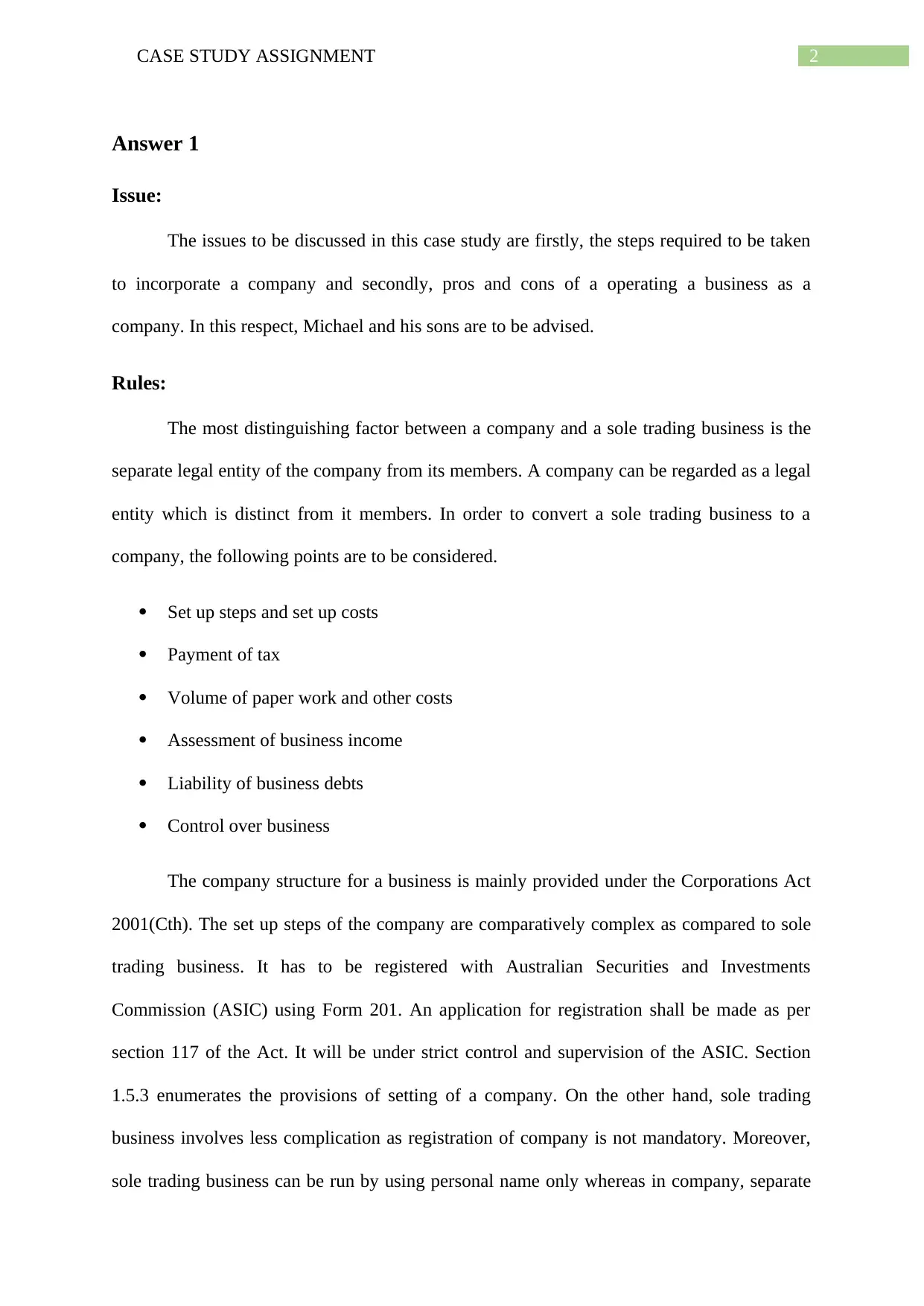
2CASE STUDY ASSIGNMENT
Answer 1
Issue:
The issues to be discussed in this case study are firstly, the steps required to be taken
to incorporate a company and secondly, pros and cons of a operating a business as a
company. In this respect, Michael and his sons are to be advised.
Rules:
The most distinguishing factor between a company and a sole trading business is the
separate legal entity of the company from its members. A company can be regarded as a legal
entity which is distinct from it members. In order to convert a sole trading business to a
company, the following points are to be considered.
Set up steps and set up costs
Payment of tax
Volume of paper work and other costs
Assessment of business income
Liability of business debts
Control over business
The company structure for a business is mainly provided under the Corporations Act
2001(Cth). The set up steps of the company are comparatively complex as compared to sole
trading business. It has to be registered with Australian Securities and Investments
Commission (ASIC) using Form 201. An application for registration shall be made as per
section 117 of the Act. It will be under strict control and supervision of the ASIC. Section
1.5.3 enumerates the provisions of setting of a company. On the other hand, sole trading
business involves less complication as registration of company is not mandatory. Moreover,
sole trading business can be run by using personal name only whereas in company, separate
Answer 1
Issue:
The issues to be discussed in this case study are firstly, the steps required to be taken
to incorporate a company and secondly, pros and cons of a operating a business as a
company. In this respect, Michael and his sons are to be advised.
Rules:
The most distinguishing factor between a company and a sole trading business is the
separate legal entity of the company from its members. A company can be regarded as a legal
entity which is distinct from it members. In order to convert a sole trading business to a
company, the following points are to be considered.
Set up steps and set up costs
Payment of tax
Volume of paper work and other costs
Assessment of business income
Liability of business debts
Control over business
The company structure for a business is mainly provided under the Corporations Act
2001(Cth). The set up steps of the company are comparatively complex as compared to sole
trading business. It has to be registered with Australian Securities and Investments
Commission (ASIC) using Form 201. An application for registration shall be made as per
section 117 of the Act. It will be under strict control and supervision of the ASIC. Section
1.5.3 enumerates the provisions of setting of a company. On the other hand, sole trading
business involves less complication as registration of company is not mandatory. Moreover,
sole trading business can be run by using personal name only whereas in company, separate
⊘ This is a preview!⊘
Do you want full access?
Subscribe today to unlock all pages.

Trusted by 1+ million students worldwide
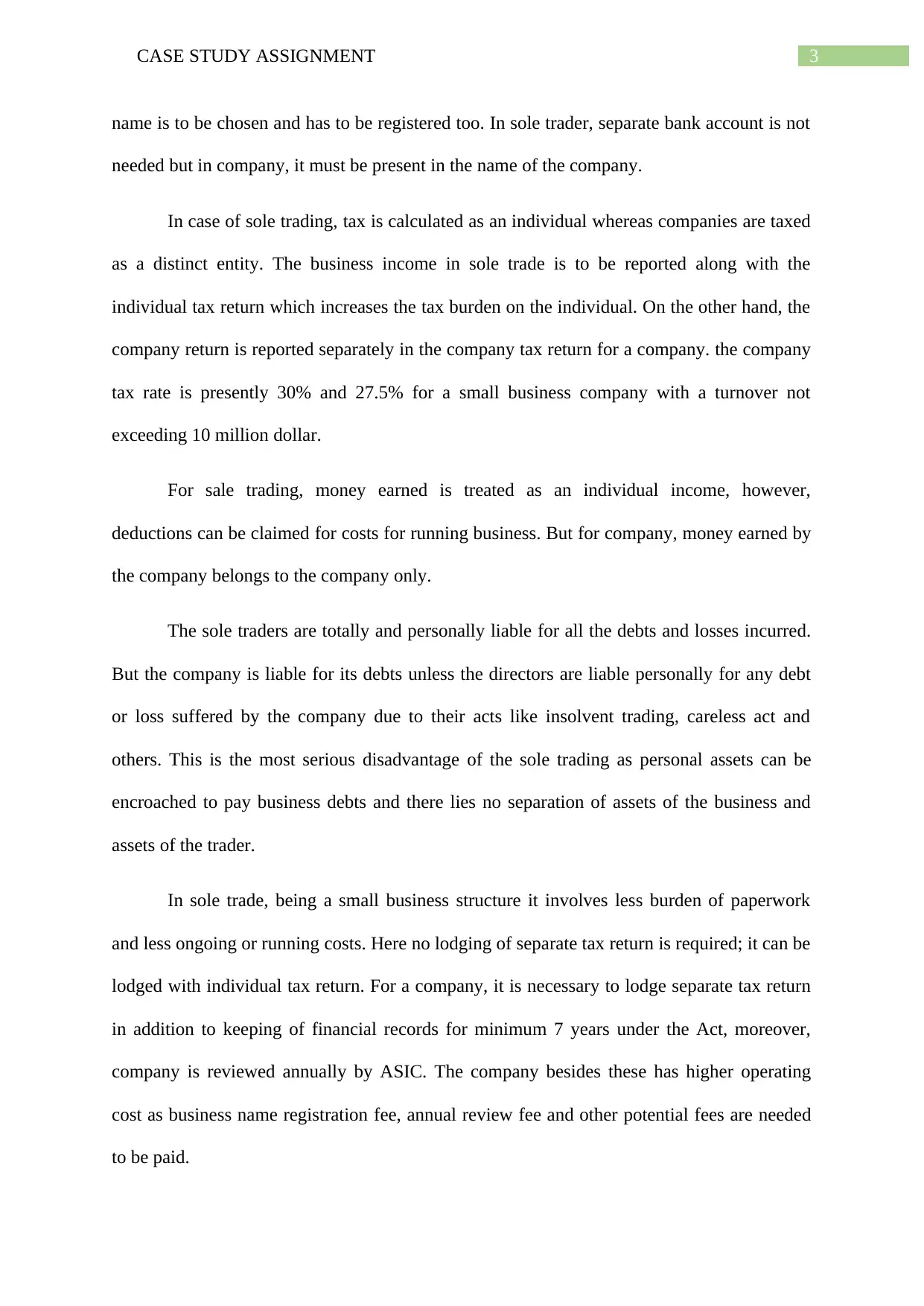
3CASE STUDY ASSIGNMENT
name is to be chosen and has to be registered too. In sole trader, separate bank account is not
needed but in company, it must be present in the name of the company.
In case of sole trading, tax is calculated as an individual whereas companies are taxed
as a distinct entity. The business income in sole trade is to be reported along with the
individual tax return which increases the tax burden on the individual. On the other hand, the
company return is reported separately in the company tax return for a company. the company
tax rate is presently 30% and 27.5% for a small business company with a turnover not
exceeding 10 million dollar.
For sale trading, money earned is treated as an individual income, however,
deductions can be claimed for costs for running business. But for company, money earned by
the company belongs to the company only.
The sole traders are totally and personally liable for all the debts and losses incurred.
But the company is liable for its debts unless the directors are liable personally for any debt
or loss suffered by the company due to their acts like insolvent trading, careless act and
others. This is the most serious disadvantage of the sole trading as personal assets can be
encroached to pay business debts and there lies no separation of assets of the business and
assets of the trader.
In sole trade, being a small business structure it involves less burden of paperwork
and less ongoing or running costs. Here no lodging of separate tax return is required; it can be
lodged with individual tax return. For a company, it is necessary to lodge separate tax return
in addition to keeping of financial records for minimum 7 years under the Act, moreover,
company is reviewed annually by ASIC. The company besides these has higher operating
cost as business name registration fee, annual review fee and other potential fees are needed
to be paid.
name is to be chosen and has to be registered too. In sole trader, separate bank account is not
needed but in company, it must be present in the name of the company.
In case of sole trading, tax is calculated as an individual whereas companies are taxed
as a distinct entity. The business income in sole trade is to be reported along with the
individual tax return which increases the tax burden on the individual. On the other hand, the
company return is reported separately in the company tax return for a company. the company
tax rate is presently 30% and 27.5% for a small business company with a turnover not
exceeding 10 million dollar.
For sale trading, money earned is treated as an individual income, however,
deductions can be claimed for costs for running business. But for company, money earned by
the company belongs to the company only.
The sole traders are totally and personally liable for all the debts and losses incurred.
But the company is liable for its debts unless the directors are liable personally for any debt
or loss suffered by the company due to their acts like insolvent trading, careless act and
others. This is the most serious disadvantage of the sole trading as personal assets can be
encroached to pay business debts and there lies no separation of assets of the business and
assets of the trader.
In sole trade, being a small business structure it involves less burden of paperwork
and less ongoing or running costs. Here no lodging of separate tax return is required; it can be
lodged with individual tax return. For a company, it is necessary to lodge separate tax return
in addition to keeping of financial records for minimum 7 years under the Act, moreover,
company is reviewed annually by ASIC. The company besides these has higher operating
cost as business name registration fee, annual review fee and other potential fees are needed
to be paid.
Paraphrase This Document
Need a fresh take? Get an instant paraphrase of this document with our AI Paraphraser
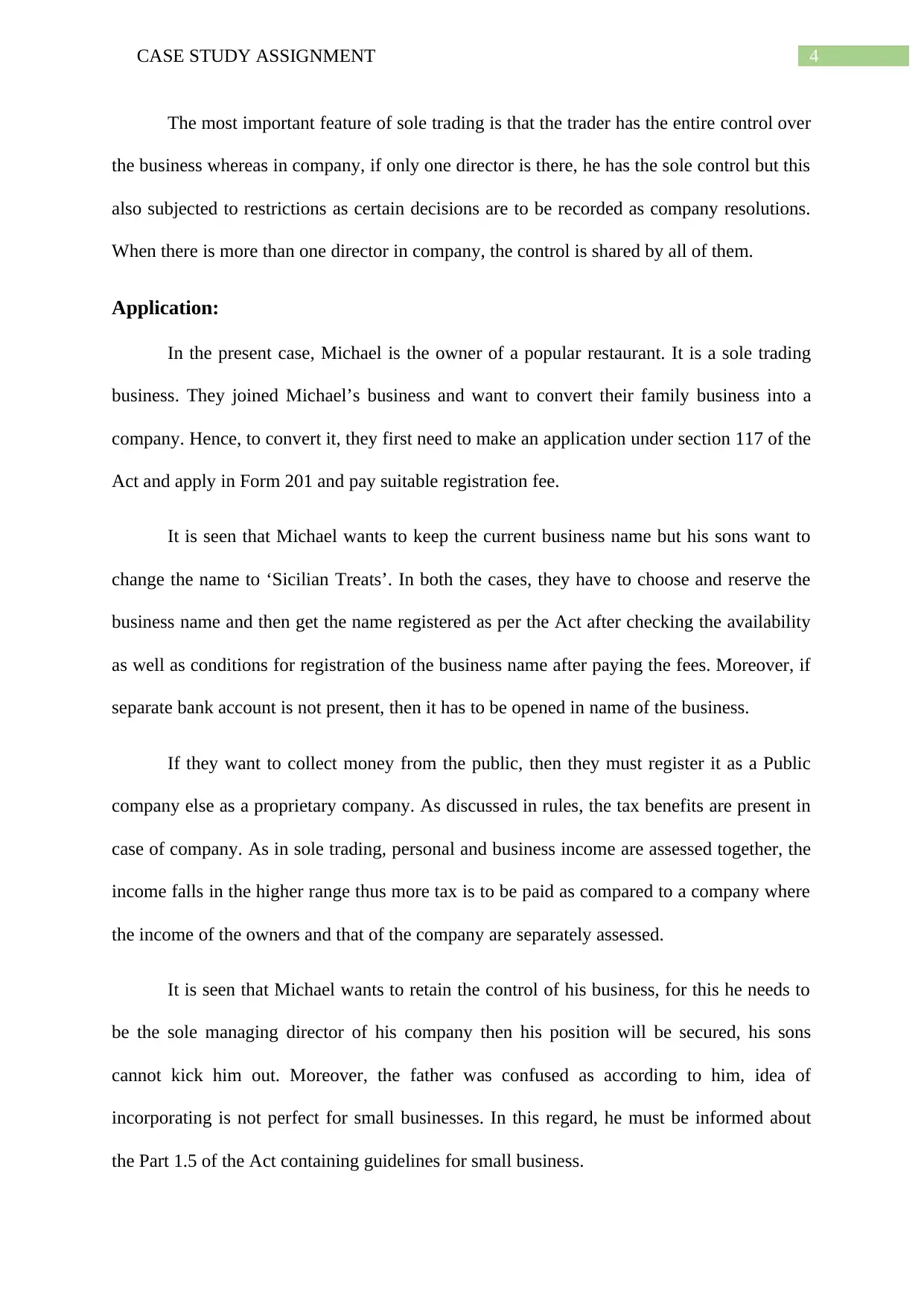
4CASE STUDY ASSIGNMENT
The most important feature of sole trading is that the trader has the entire control over
the business whereas in company, if only one director is there, he has the sole control but this
also subjected to restrictions as certain decisions are to be recorded as company resolutions.
When there is more than one director in company, the control is shared by all of them.
Application:
In the present case, Michael is the owner of a popular restaurant. It is a sole trading
business. They joined Michael’s business and want to convert their family business into a
company. Hence, to convert it, they first need to make an application under section 117 of the
Act and apply in Form 201 and pay suitable registration fee.
It is seen that Michael wants to keep the current business name but his sons want to
change the name to ‘Sicilian Treats’. In both the cases, they have to choose and reserve the
business name and then get the name registered as per the Act after checking the availability
as well as conditions for registration of the business name after paying the fees. Moreover, if
separate bank account is not present, then it has to be opened in name of the business.
If they want to collect money from the public, then they must register it as a Public
company else as a proprietary company. As discussed in rules, the tax benefits are present in
case of company. As in sole trading, personal and business income are assessed together, the
income falls in the higher range thus more tax is to be paid as compared to a company where
the income of the owners and that of the company are separately assessed.
It is seen that Michael wants to retain the control of his business, for this he needs to
be the sole managing director of his company then his position will be secured, his sons
cannot kick him out. Moreover, the father was confused as according to him, idea of
incorporating is not perfect for small businesses. In this regard, he must be informed about
the Part 1.5 of the Act containing guidelines for small business.
The most important feature of sole trading is that the trader has the entire control over
the business whereas in company, if only one director is there, he has the sole control but this
also subjected to restrictions as certain decisions are to be recorded as company resolutions.
When there is more than one director in company, the control is shared by all of them.
Application:
In the present case, Michael is the owner of a popular restaurant. It is a sole trading
business. They joined Michael’s business and want to convert their family business into a
company. Hence, to convert it, they first need to make an application under section 117 of the
Act and apply in Form 201 and pay suitable registration fee.
It is seen that Michael wants to keep the current business name but his sons want to
change the name to ‘Sicilian Treats’. In both the cases, they have to choose and reserve the
business name and then get the name registered as per the Act after checking the availability
as well as conditions for registration of the business name after paying the fees. Moreover, if
separate bank account is not present, then it has to be opened in name of the business.
If they want to collect money from the public, then they must register it as a Public
company else as a proprietary company. As discussed in rules, the tax benefits are present in
case of company. As in sole trading, personal and business income are assessed together, the
income falls in the higher range thus more tax is to be paid as compared to a company where
the income of the owners and that of the company are separately assessed.
It is seen that Michael wants to retain the control of his business, for this he needs to
be the sole managing director of his company then his position will be secured, his sons
cannot kick him out. Moreover, the father was confused as according to him, idea of
incorporating is not perfect for small businesses. In this regard, he must be informed about
the Part 1.5 of the Act containing guidelines for small business.
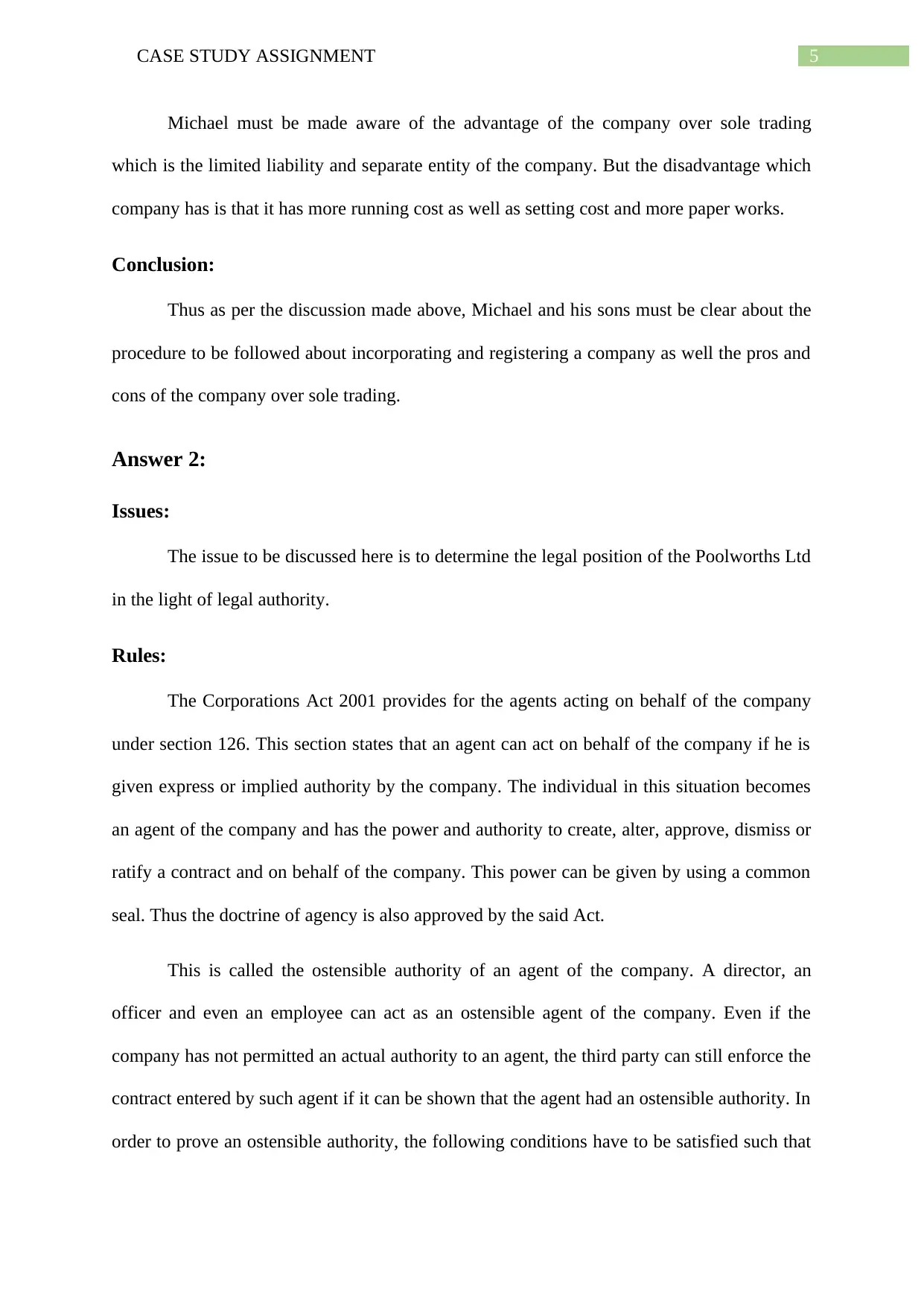
5CASE STUDY ASSIGNMENT
Michael must be made aware of the advantage of the company over sole trading
which is the limited liability and separate entity of the company. But the disadvantage which
company has is that it has more running cost as well as setting cost and more paper works.
Conclusion:
Thus as per the discussion made above, Michael and his sons must be clear about the
procedure to be followed about incorporating and registering a company as well the pros and
cons of the company over sole trading.
Answer 2:
Issues:
The issue to be discussed here is to determine the legal position of the Poolworths Ltd
in the light of legal authority.
Rules:
The Corporations Act 2001 provides for the agents acting on behalf of the company
under section 126. This section states that an agent can act on behalf of the company if he is
given express or implied authority by the company. The individual in this situation becomes
an agent of the company and has the power and authority to create, alter, approve, dismiss or
ratify a contract and on behalf of the company. This power can be given by using a common
seal. Thus the doctrine of agency is also approved by the said Act.
This is called the ostensible authority of an agent of the company. A director, an
officer and even an employee can act as an ostensible agent of the company. Even if the
company has not permitted an actual authority to an agent, the third party can still enforce the
contract entered by such agent if it can be shown that the agent had an ostensible authority. In
order to prove an ostensible authority, the following conditions have to be satisfied such that
Michael must be made aware of the advantage of the company over sole trading
which is the limited liability and separate entity of the company. But the disadvantage which
company has is that it has more running cost as well as setting cost and more paper works.
Conclusion:
Thus as per the discussion made above, Michael and his sons must be clear about the
procedure to be followed about incorporating and registering a company as well the pros and
cons of the company over sole trading.
Answer 2:
Issues:
The issue to be discussed here is to determine the legal position of the Poolworths Ltd
in the light of legal authority.
Rules:
The Corporations Act 2001 provides for the agents acting on behalf of the company
under section 126. This section states that an agent can act on behalf of the company if he is
given express or implied authority by the company. The individual in this situation becomes
an agent of the company and has the power and authority to create, alter, approve, dismiss or
ratify a contract and on behalf of the company. This power can be given by using a common
seal. Thus the doctrine of agency is also approved by the said Act.
This is called the ostensible authority of an agent of the company. A director, an
officer and even an employee can act as an ostensible agent of the company. Even if the
company has not permitted an actual authority to an agent, the third party can still enforce the
contract entered by such agent if it can be shown that the agent had an ostensible authority. In
order to prove an ostensible authority, the following conditions have to be satisfied such that
⊘ This is a preview!⊘
Do you want full access?
Subscribe today to unlock all pages.

Trusted by 1+ million students worldwide
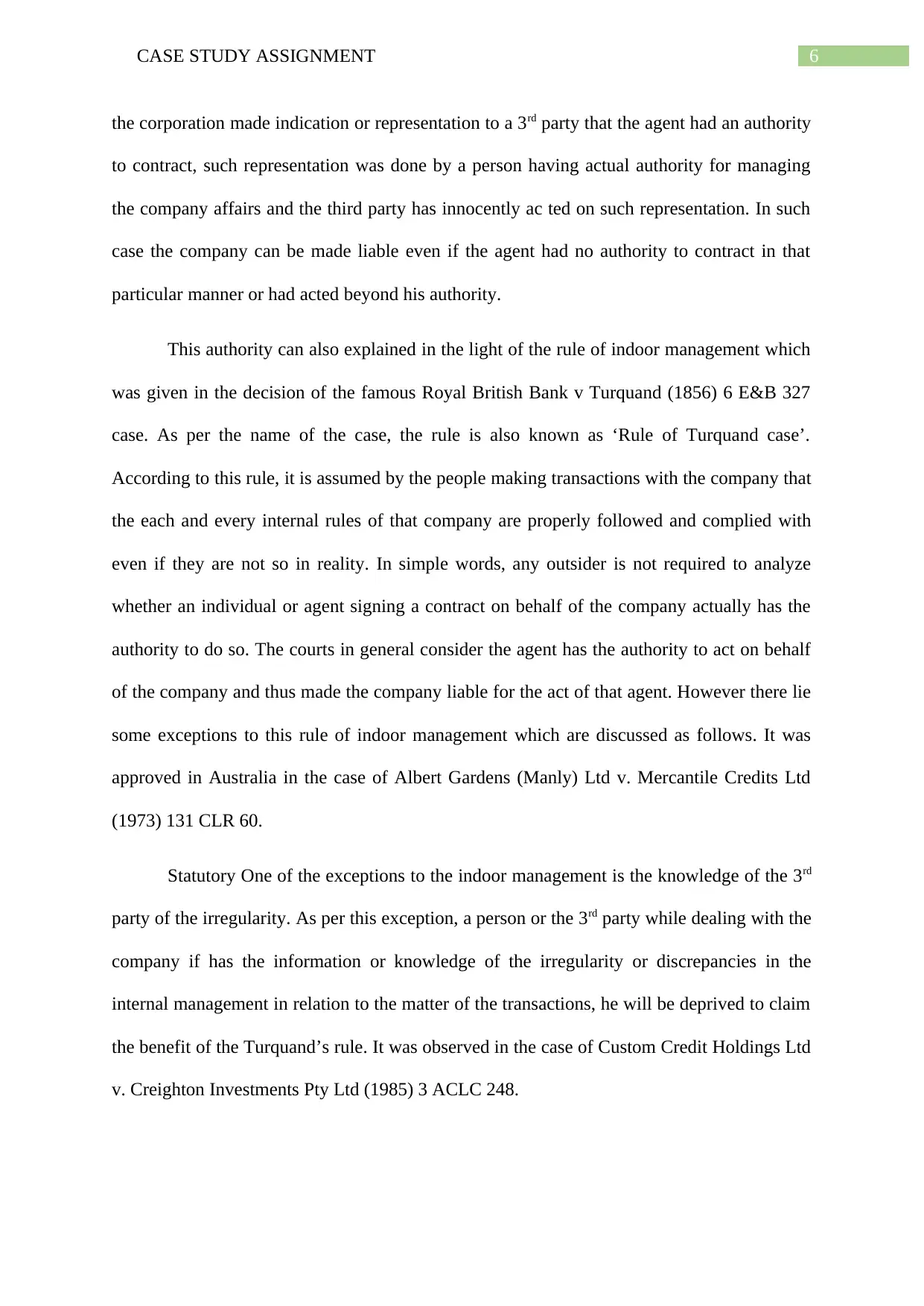
6CASE STUDY ASSIGNMENT
the corporation made indication or representation to a 3rd party that the agent had an authority
to contract, such representation was done by a person having actual authority for managing
the company affairs and the third party has innocently ac ted on such representation. In such
case the company can be made liable even if the agent had no authority to contract in that
particular manner or had acted beyond his authority.
This authority can also explained in the light of the rule of indoor management which
was given in the decision of the famous Royal British Bank v Turquand (1856) 6 E&B 327
case. As per the name of the case, the rule is also known as ‘Rule of Turquand case’.
According to this rule, it is assumed by the people making transactions with the company that
the each and every internal rules of that company are properly followed and complied with
even if they are not so in reality. In simple words, any outsider is not required to analyze
whether an individual or agent signing a contract on behalf of the company actually has the
authority to do so. The courts in general consider the agent has the authority to act on behalf
of the company and thus made the company liable for the act of that agent. However there lie
some exceptions to this rule of indoor management which are discussed as follows. It was
approved in Australia in the case of Albert Gardens (Manly) Ltd v. Mercantile Credits Ltd
(1973) 131 CLR 60.
Statutory One of the exceptions to the indoor management is the knowledge of the 3rd
party of the irregularity. As per this exception, a person or the 3rd party while dealing with the
company if has the information or knowledge of the irregularity or discrepancies in the
internal management in relation to the matter of the transactions, he will be deprived to claim
the benefit of the Turquand’s rule. It was observed in the case of Custom Credit Holdings Ltd
v. Creighton Investments Pty Ltd (1985) 3 ACLC 248.
the corporation made indication or representation to a 3rd party that the agent had an authority
to contract, such representation was done by a person having actual authority for managing
the company affairs and the third party has innocently ac ted on such representation. In such
case the company can be made liable even if the agent had no authority to contract in that
particular manner or had acted beyond his authority.
This authority can also explained in the light of the rule of indoor management which
was given in the decision of the famous Royal British Bank v Turquand (1856) 6 E&B 327
case. As per the name of the case, the rule is also known as ‘Rule of Turquand case’.
According to this rule, it is assumed by the people making transactions with the company that
the each and every internal rules of that company are properly followed and complied with
even if they are not so in reality. In simple words, any outsider is not required to analyze
whether an individual or agent signing a contract on behalf of the company actually has the
authority to do so. The courts in general consider the agent has the authority to act on behalf
of the company and thus made the company liable for the act of that agent. However there lie
some exceptions to this rule of indoor management which are discussed as follows. It was
approved in Australia in the case of Albert Gardens (Manly) Ltd v. Mercantile Credits Ltd
(1973) 131 CLR 60.
Statutory One of the exceptions to the indoor management is the knowledge of the 3rd
party of the irregularity. As per this exception, a person or the 3rd party while dealing with the
company if has the information or knowledge of the irregularity or discrepancies in the
internal management in relation to the matter of the transactions, he will be deprived to claim
the benefit of the Turquand’s rule. It was observed in the case of Custom Credit Holdings Ltd
v. Creighton Investments Pty Ltd (1985) 3 ACLC 248.
Paraphrase This Document
Need a fresh take? Get an instant paraphrase of this document with our AI Paraphraser
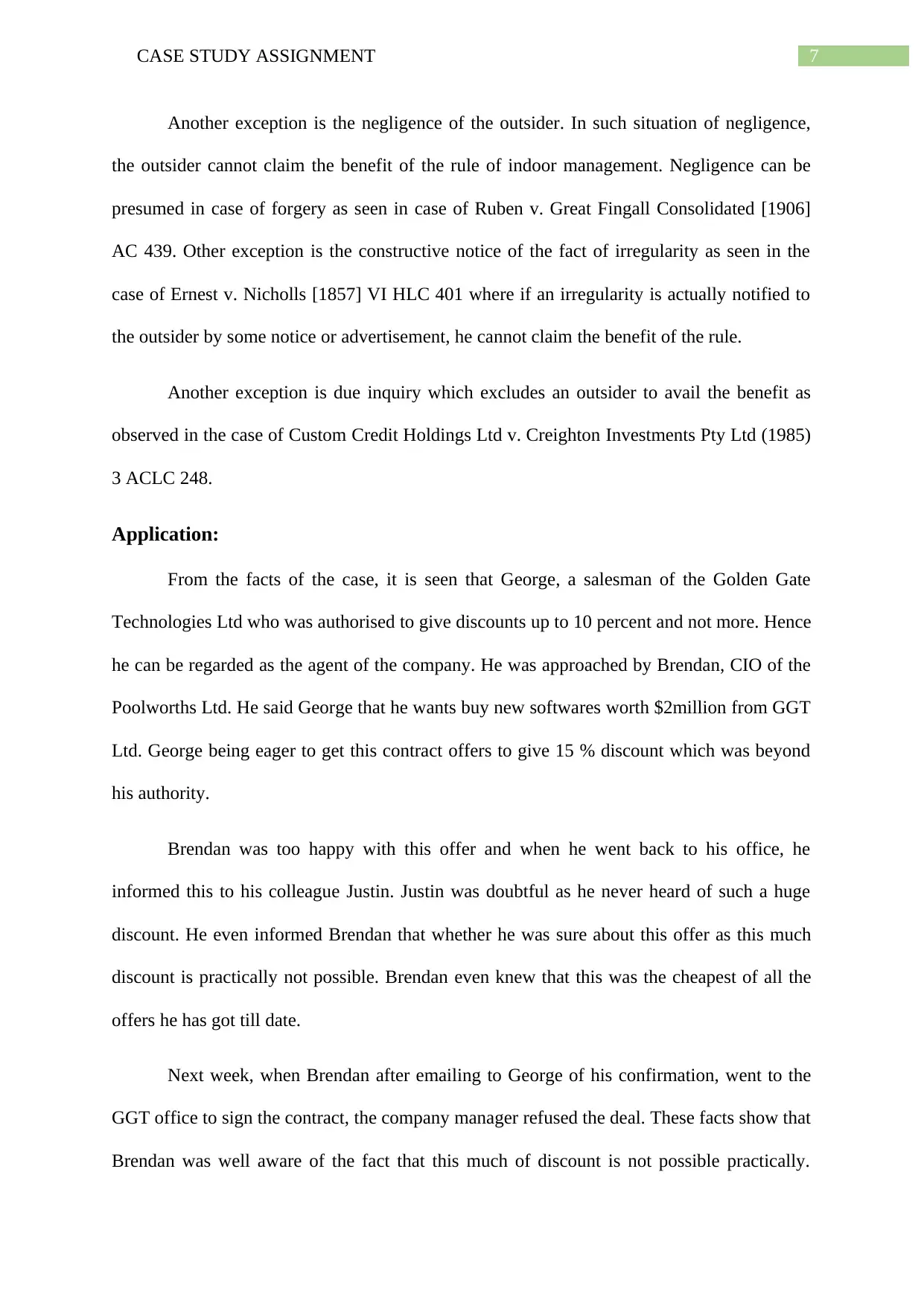
7CASE STUDY ASSIGNMENT
Another exception is the negligence of the outsider. In such situation of negligence,
the outsider cannot claim the benefit of the rule of indoor management. Negligence can be
presumed in case of forgery as seen in case of Ruben v. Great Fingall Consolidated [1906]
AC 439. Other exception is the constructive notice of the fact of irregularity as seen in the
case of Ernest v. Nicholls [1857] VI HLC 401 where if an irregularity is actually notified to
the outsider by some notice or advertisement, he cannot claim the benefit of the rule.
Another exception is due inquiry which excludes an outsider to avail the benefit as
observed in the case of Custom Credit Holdings Ltd v. Creighton Investments Pty Ltd (1985)
3 ACLC 248.
Application:
From the facts of the case, it is seen that George, a salesman of the Golden Gate
Technologies Ltd who was authorised to give discounts up to 10 percent and not more. Hence
he can be regarded as the agent of the company. He was approached by Brendan, CIO of the
Poolworths Ltd. He said George that he wants buy new softwares worth $2million from GGT
Ltd. George being eager to get this contract offers to give 15 % discount which was beyond
his authority.
Brendan was too happy with this offer and when he went back to his office, he
informed this to his colleague Justin. Justin was doubtful as he never heard of such a huge
discount. He even informed Brendan that whether he was sure about this offer as this much
discount is practically not possible. Brendan even knew that this was the cheapest of all the
offers he has got till date.
Next week, when Brendan after emailing to George of his confirmation, went to the
GGT office to sign the contract, the company manager refused the deal. These facts show that
Brendan was well aware of the fact that this much of discount is not possible practically.
Another exception is the negligence of the outsider. In such situation of negligence,
the outsider cannot claim the benefit of the rule of indoor management. Negligence can be
presumed in case of forgery as seen in case of Ruben v. Great Fingall Consolidated [1906]
AC 439. Other exception is the constructive notice of the fact of irregularity as seen in the
case of Ernest v. Nicholls [1857] VI HLC 401 where if an irregularity is actually notified to
the outsider by some notice or advertisement, he cannot claim the benefit of the rule.
Another exception is due inquiry which excludes an outsider to avail the benefit as
observed in the case of Custom Credit Holdings Ltd v. Creighton Investments Pty Ltd (1985)
3 ACLC 248.
Application:
From the facts of the case, it is seen that George, a salesman of the Golden Gate
Technologies Ltd who was authorised to give discounts up to 10 percent and not more. Hence
he can be regarded as the agent of the company. He was approached by Brendan, CIO of the
Poolworths Ltd. He said George that he wants buy new softwares worth $2million from GGT
Ltd. George being eager to get this contract offers to give 15 % discount which was beyond
his authority.
Brendan was too happy with this offer and when he went back to his office, he
informed this to his colleague Justin. Justin was doubtful as he never heard of such a huge
discount. He even informed Brendan that whether he was sure about this offer as this much
discount is practically not possible. Brendan even knew that this was the cheapest of all the
offers he has got till date.
Next week, when Brendan after emailing to George of his confirmation, went to the
GGT office to sign the contract, the company manager refused the deal. These facts show that
Brendan was well aware of the fact that this much of discount is not possible practically.
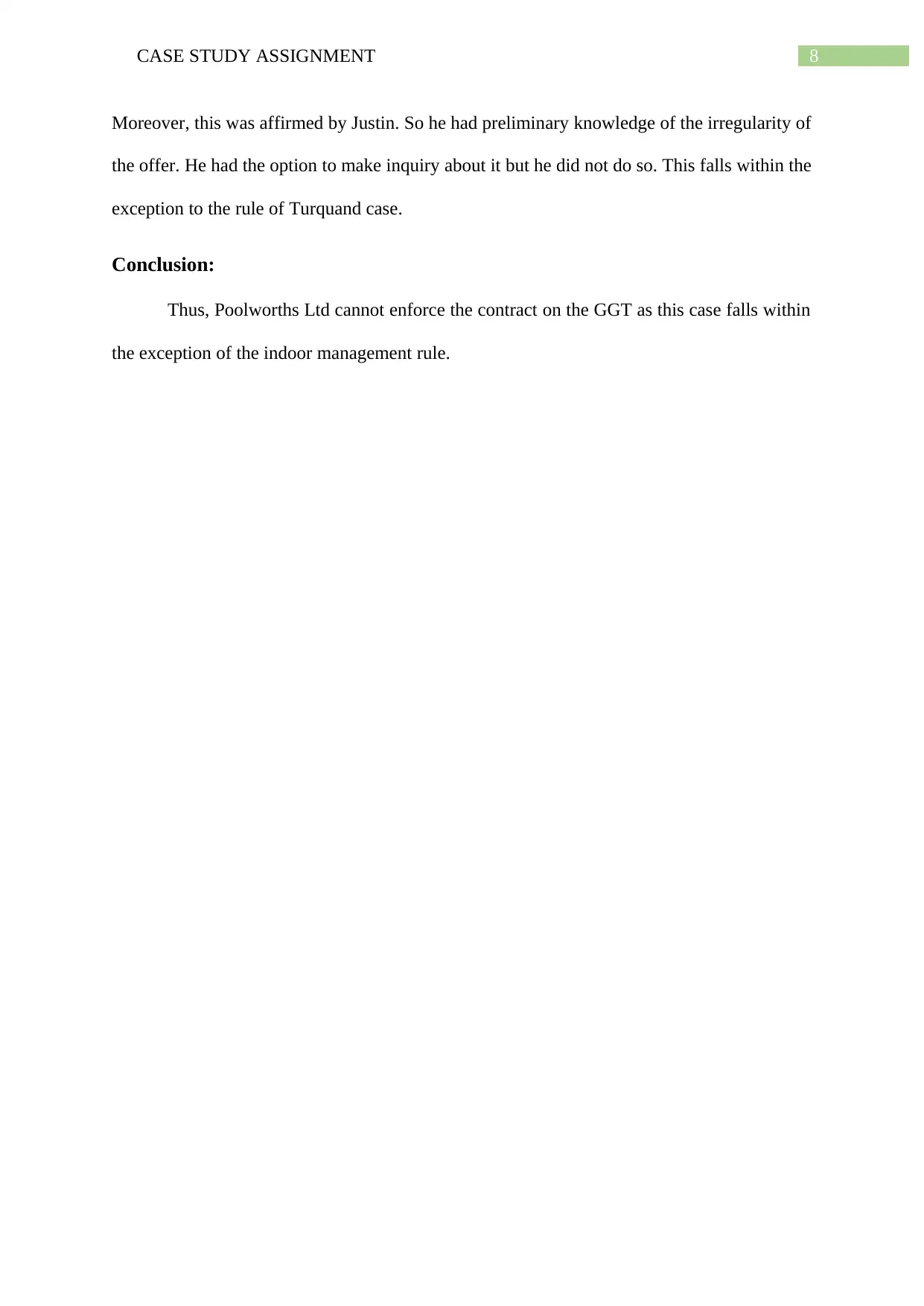
8CASE STUDY ASSIGNMENT
Moreover, this was affirmed by Justin. So he had preliminary knowledge of the irregularity of
the offer. He had the option to make inquiry about it but he did not do so. This falls within the
exception to the rule of Turquand case.
Conclusion:
Thus, Poolworths Ltd cannot enforce the contract on the GGT as this case falls within
the exception of the indoor management rule.
Moreover, this was affirmed by Justin. So he had preliminary knowledge of the irregularity of
the offer. He had the option to make inquiry about it but he did not do so. This falls within the
exception to the rule of Turquand case.
Conclusion:
Thus, Poolworths Ltd cannot enforce the contract on the GGT as this case falls within
the exception of the indoor management rule.
⊘ This is a preview!⊘
Do you want full access?
Subscribe today to unlock all pages.

Trusted by 1+ million students worldwide
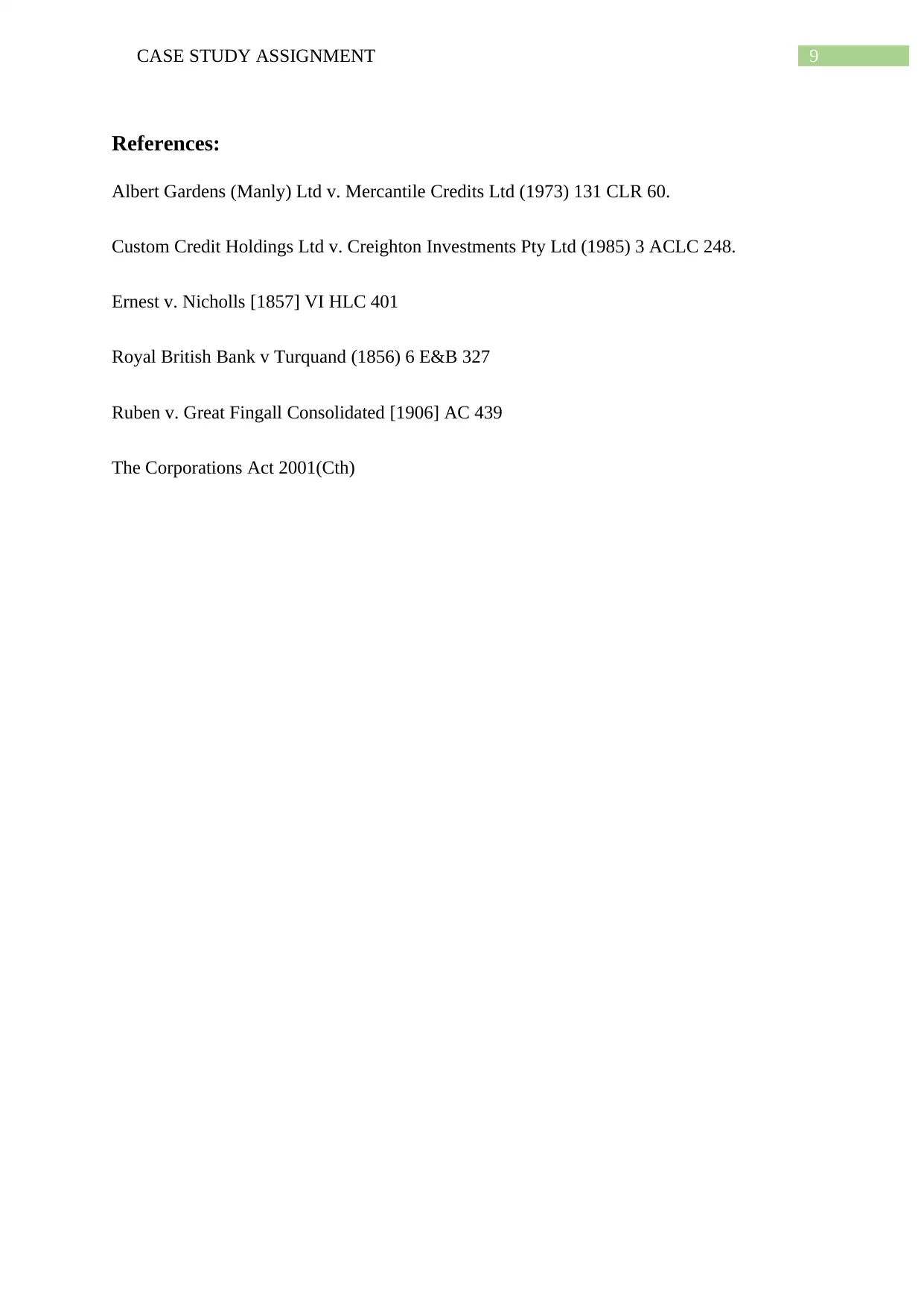
9CASE STUDY ASSIGNMENT
References:
Albert Gardens (Manly) Ltd v. Mercantile Credits Ltd (1973) 131 CLR 60.
Custom Credit Holdings Ltd v. Creighton Investments Pty Ltd (1985) 3 ACLC 248.
Ernest v. Nicholls [1857] VI HLC 401
Royal British Bank v Turquand (1856) 6 E&B 327
Ruben v. Great Fingall Consolidated [1906] AC 439
The Corporations Act 2001(Cth)
References:
Albert Gardens (Manly) Ltd v. Mercantile Credits Ltd (1973) 131 CLR 60.
Custom Credit Holdings Ltd v. Creighton Investments Pty Ltd (1985) 3 ACLC 248.
Ernest v. Nicholls [1857] VI HLC 401
Royal British Bank v Turquand (1856) 6 E&B 327
Ruben v. Great Fingall Consolidated [1906] AC 439
The Corporations Act 2001(Cth)
1 out of 10
Related Documents
Your All-in-One AI-Powered Toolkit for Academic Success.
+13062052269
info@desklib.com
Available 24*7 on WhatsApp / Email
![[object Object]](/_next/static/media/star-bottom.7253800d.svg)
Unlock your academic potential
Copyright © 2020–2025 A2Z Services. All Rights Reserved. Developed and managed by ZUCOL.





